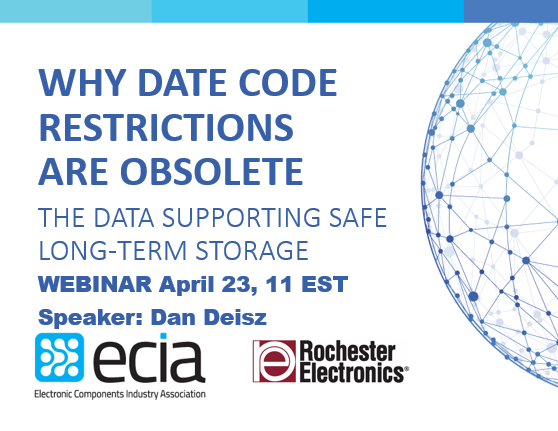In an eye-opening ECIA webinar, hosted by EMSNOW's Publisher Eric Miscoll, Dan Deisz of Rochester Electronics reported on tests conducted on a comprehensive selection of chip packages, aged 8-22 years, to put to rest - once and for all - customer concerns about solderability. (“Why Date Code Restrictions Are Obsolete” Recording, Presentation Deck
The tests compared results of two widely used test methodologies from EIA/IPC/JEDEC J-STD-002: the wave solder bath process known as ‘dip and look’ and the more modern surface mount process simulation test. In neither test was there any correlation between failures and date code/age of the package. In the more modern test, based on real-world processes, there were no failures at all.
Why is this issue so important? Date code restrictions hurt everybody.
Date code restrictions are a challenge for the entire industry as supply chain disruptions occur with greater frequency. Forecasts are unreliable, so when demand fluctuates in any end market, pockets of excess inventory crop up, affecting the bottom lines of distributors and customers alike. When shortages occur, customers often are forced to disregard date code restrictions, balancing the risk of component failure against the larger risks of not having enough chips to build their products. For systems that don’t need to last for decades, the risk of failure is non-existent, as tests have proven. Two-year date codes make no sense.
Tariffs add another level of urgency.
After several years of market volatility and geopolitical shifts, many companies have a lot of aging inventory on their shelves. This inventory is already purchased with no tariff implications. If that two-year date code is held, then that inventory has to be written off and scrapped, and new inventory must be purchased with added tariffs, making it more expensive. Also, there may be long lead times still for certain components, which causes additional financial and scheduling woes.
According to Dan Deisz, this issue especially affects industries where electronics need to be high-reliability and last for many years: industrial, avionics, military, and, now increasingly, automotive electronics. When semiconductor companies discontinue components, OEMs in these industries must buy and store parts for many years to support these systems. If, even in these very critical industries, the tests show that it is safe to use components that are 8 to 22 years old, the much shorter date code restrictions in place for other industries are clearly unnecessary.
The industry must accept these conclusive solderability test results on semiconductors that are past current date codes, come from the authorized channel, and have been stored properly. The time has come to address the business issues preventing the elimination of these wasteful practices. The industry must move away from unreasonable date code restrictions without a technical basis and accept properly stored, fully authorized components..
ECIA has teamed up with JEDEC, IPC and EMSNOW to drive awareness and change in the broader electronics ecosystem.
The first phase is a webinar series moderated by EMSNOW.com's publisher, Eric Miscoll. EMSNOW is a leading publication serving the electronic manufacturing services (EMS) industry, and its OEM customers and suppliers. In addition, ECIA’s Global Industry Practices Committee (GIPC) will report on joint IPC-ECIA survey data regarding the EMS/OEM customer community’s attitudes and beliefs about this critical supply chain issue.
“Obsolete date codes not only cost suppliers and distributors money, but also cost their customers, especially EMS companies, a lot of money,” noted ECIA President and CEO David Loftus. “Many end customers of the EMS place arbitrary limits on date codes that their manufacturing partners are allowed to use on their builds. EMS companies sit on considerable inventory for their end customers, and some of it eventually exceeds two or three years. If we can arm EMS companies with the right information and data, they can push back on those limits and utilize more of the stock they have on their shelves instead of writing it off, at a big loss, and likely shipping it on to the broker channel. This will save the EMS company lots of money and headaches,” he concluded.
“This is an important issue that I suspect is currently not on the radar for most of the EMS/OEM community,” added Eric Miscoll, EMSNOW Publisher. “I look forward to learning more about the supply chain, engineering, and business issues related to date code restrictions and bringing this information to our EMS executive audience.”
The first webinar took place on April 23: “Why Date Code Restrictions Are Obsolete” Webinar; Recording, Presentation Deck
Webinar 2: “The Supply Chain Implications of Date Codes” is scheduled for July. Watch for details.
Webinar 3: "Next Steps: Where Does the Industry Go From Here" will take place in the fall.
Additional Resources from Rochester Electronics:
Compatibility of Traditional Solderability Testing for Aged Semiconductor Components
The Effects of Long-Term Storage on Solderability of Semiconductor Components

